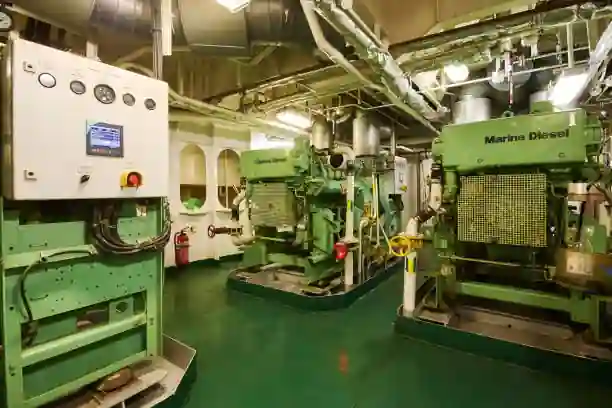
Blog: Benefits of Automatic DP System for Marine Engineering
- John Kennedy
- Marine Automaiton, Marine Control Systems
- 04 Oct, 2023
Introduction
In the dynamic realm of marine engineering, precision, reliability, and safety are of utmost importance. Imagine a vessel that can effortlessly maintain its position and heading, automatically responding to environmental forces and safeguarding both crew and cargo during operation such as Drilling, and FPSO.
This remarkable feat is made achievable by Automatic Dynamic Positioning (DP) Systems. In this all-encompassing guide, we'll delve into the world of DP systems, exploring their components, operations, and their wide array of applications and benefits. Whether you're a seasoned marine professional or new to this fascinating field, there's valuable information here for everyone.
Components of a DP System
A DP system is a sophisticated ensemble of components, each playing a crucial role in ensuring the vessel's stability and safety. These components include:
- Position Reference System: Utilizing sensors like GPS and DGPS, this System precisely determines the vessel's position.
- Environment Reference System: Environmental forces can be unpredictable. Wind sensors, wave sensors, and current sensors are used to measure these forces, ensuring the vessel can respond effectively.
- Heading Reference System: Consisting of gyroscopes and compasses, this system determines the vessel's heading, critical for maintaining the desired direction.
- Propulsion System: Thrusters are at the heart of a DP system, enabling precise control over the vessel's position and heading.
- Power System: Reliable power is essential for both the DP system and the thrusters, ensuring continuous operation.
- Control System: Often referred to as the 'brain' of the DP system, this component receives data from the position reference, environment reference, and heading reference systems. It then calculates the thruster forces needed to maintain the vessel's position and heading.
Types of DP Systems
The IMO has categorized DP Systems into three equipment classes based on redundancy and protection. The necessary redundancy level for the components and systems are determined by the consequence of the loss of vessel position and/or heading. A loss of position and/or heading may occur in the event of a single fault
- DP1: Designed to maintain position in the event of a single failure in any active component or system.
- DP2: Offers redundancy by ensuring position maintenance despite a single failure in any active component or system and any normally static component.
- DP3: The highest level of redundancy, ensuring position retention even with a single failure in any active component or system, any normally static component, and any watertight compartment.
Applications of DP Systems
As the utilization of Dynamic Positioning Systems expands within the maritime sector, various categories of ships are now integrating DP systems to enhance their command and maneuverability when navigating the open waters. While dynamic positioning-equipped vessels are traditionally associated with offshore activities, it's noteworthy that an increasing number of contemporary cargo and passenger vessels are also adopting DP systems.
- Offshore Oil and Gas Exploration and Production: DP systems play a pivotal role in keeping vessels steady during offshore drilling and production operations, enhancing safety and efficiency.
- Cable Laying: When laying underwater cables, precision is crucial. DP systems ensure vessels maintain their positions accurately, preventing cable damage.
- Research: Scientific research vessels rely on DP systems to stay in position during experiments, collecting accurate data without drifting.
Benefits of Using DP Systems
Dynamics Positioning (DP) systems empower vessels to autonomously uphold their position and heading through the utilization of thrusters and propellers. These systems constitute a vital component of offshore activities encompassing oil and gas exploration, subsea construction, and marine research. However, what has been the evolutionary journey of DP systems, transitioning from analog to digital technology? In this piece, we embark on a journey through time, tracing the historical progression and contemporary developments of DP systems from their inception in the 1960s to the present day.
- Enhanced Safety: DP systems play a pivotal role in reducing the likelihood of accidents involving collisions with both vessels and maritime structures. This contributes significantly to an overall improvement in safety standards within the maritime industry.
- Increased Efficiency & Performance: By maintaining position during operations such as drilling, DP systems reduce the time required for tasks, translating into cost savings and operational efficiency.
- Reduced Environmental Impact: The avoidance of anchor use minimizes disturbances to the seabed, reducing the environmental footprint of marine operations.
Automatic DP systems are the unsung heroes of marine engineering, offering precision, safety, and efficiency to a wide array of maritime operations. Whether you're in the oil and gas sector, cable laying, or scientific research, DP systems are revolutionizing the way vessels maintain position and heading. Ashmit Engineering Ltd. emerges as a trusted partner, ready to assist marine operators in harnessing the full potential of this transformative technology. With DP systems, the seas have never benefits safer or more accessible.
Tags :
- Automatic DP system
- Marine engineering
- Control systems
- Ashmit Engineering
- Reliability
- Performance
- Safety
- Offshore oil and gas exploration
- Cable laying
- Scientific research
- Position reference system
- Environment reference system
- Heading reference system
- Propulsion system
- Power system
- Control system
- IMO DP classes
- DP1
- DP2
- DP3
- Benefits of DP systems

